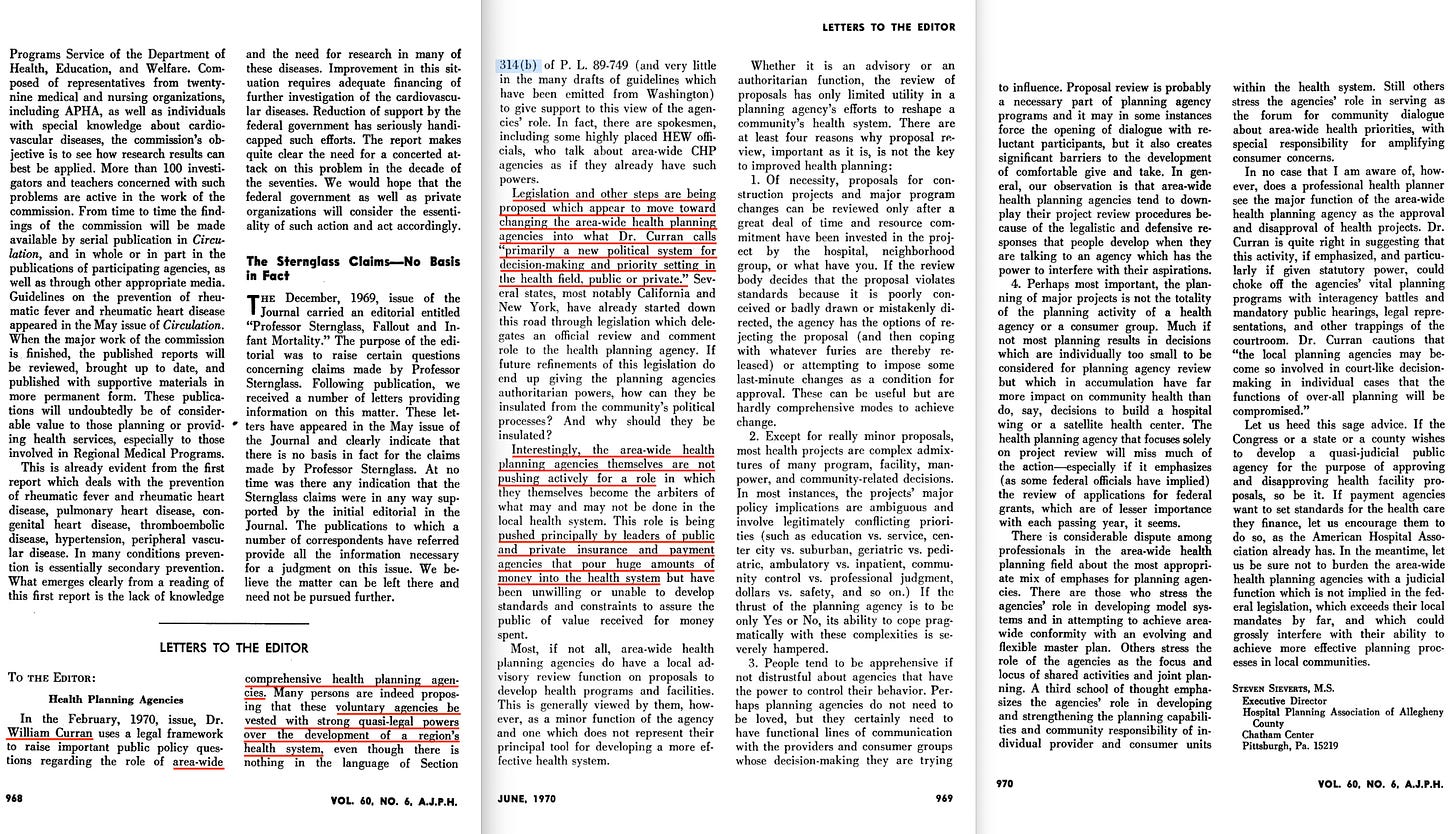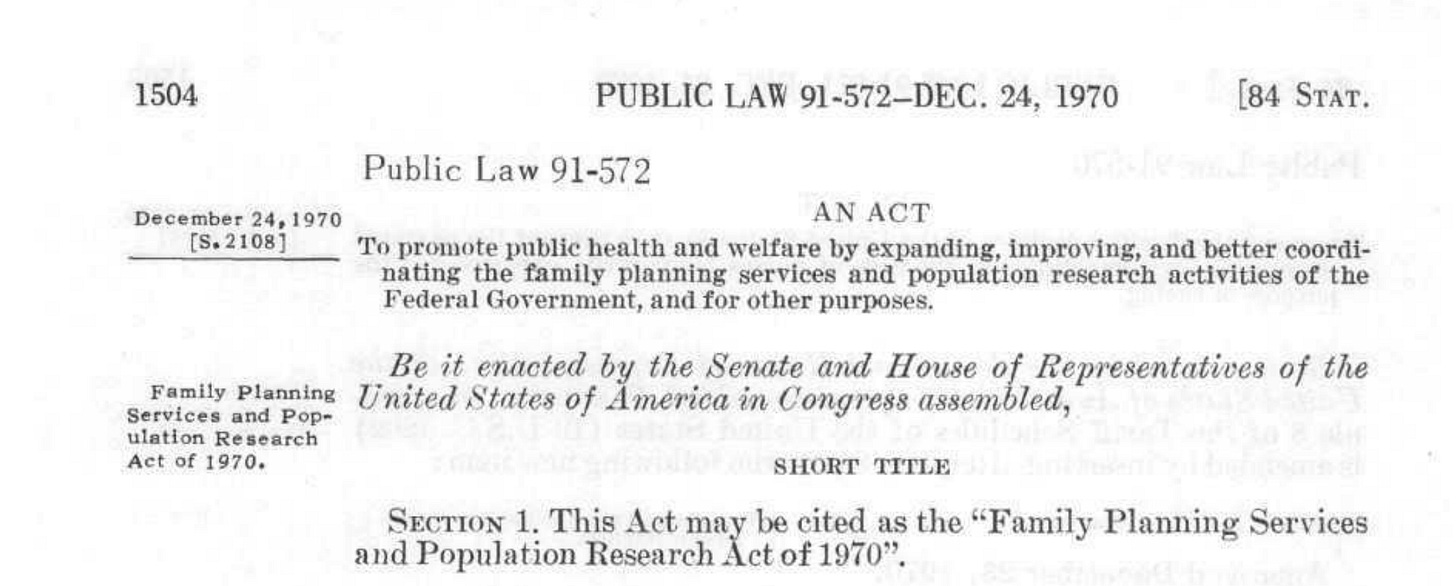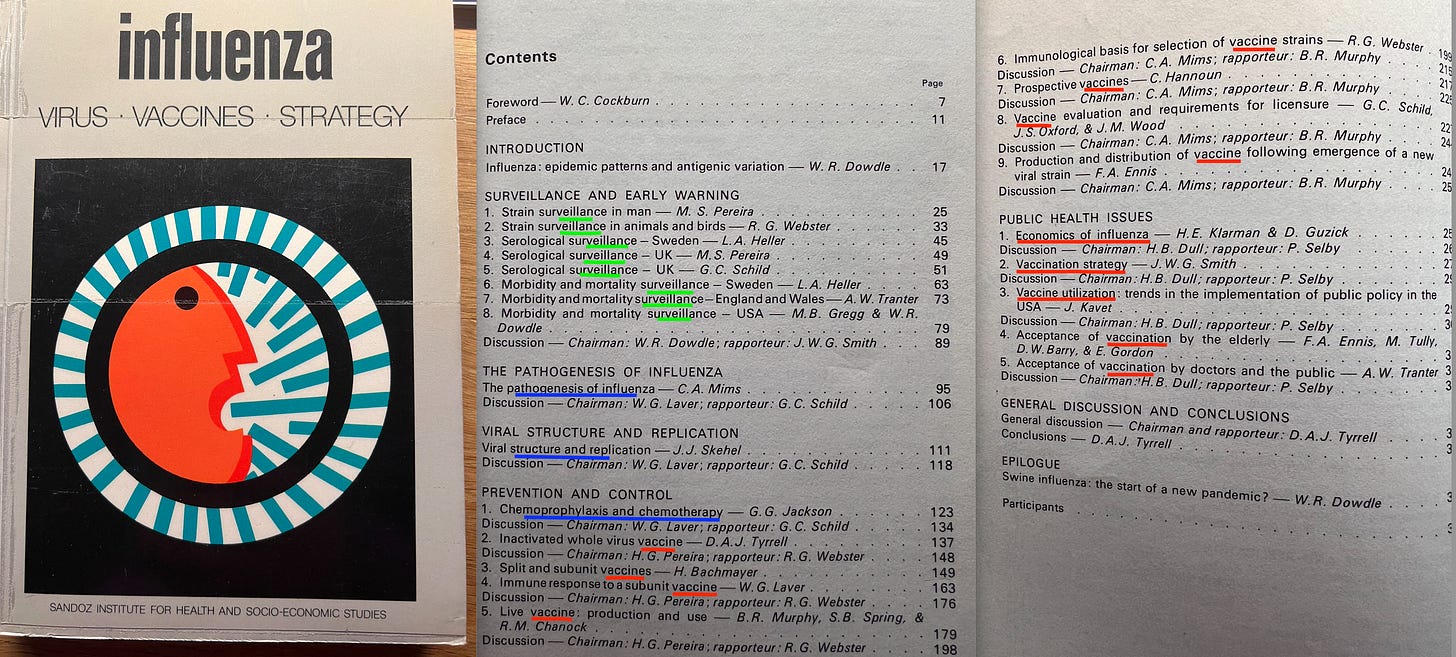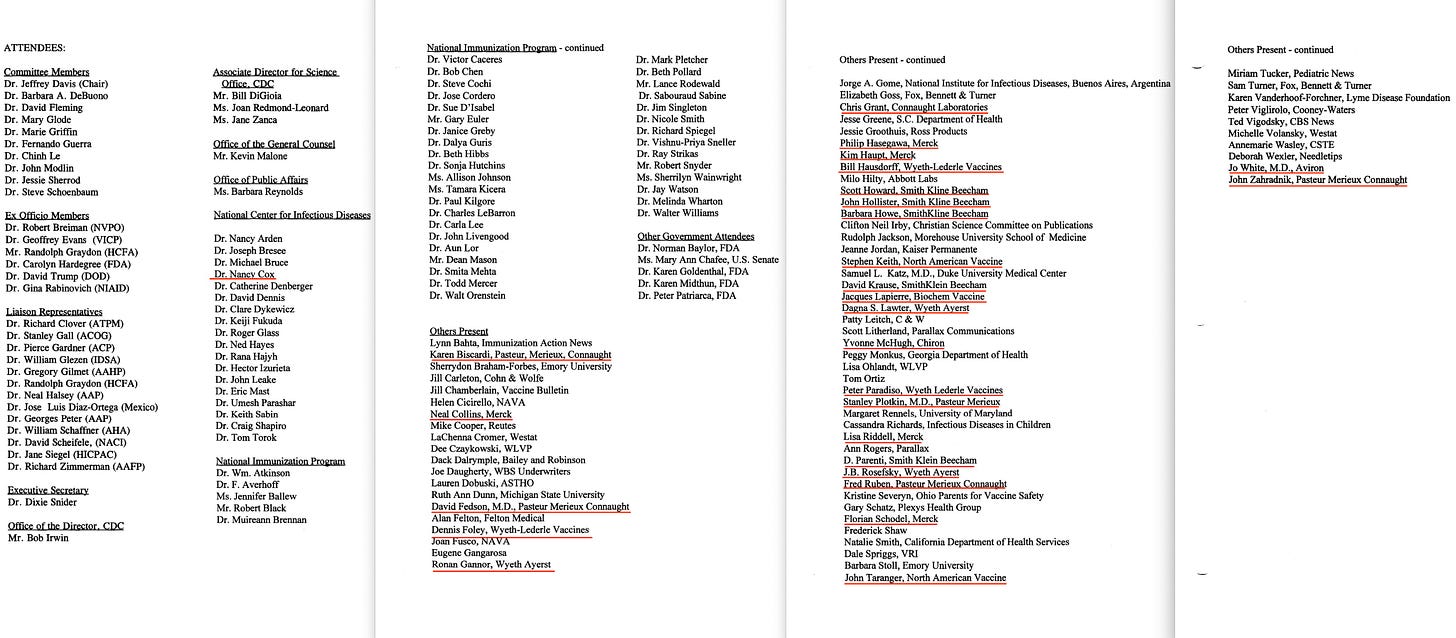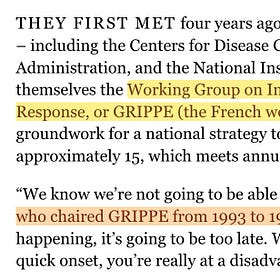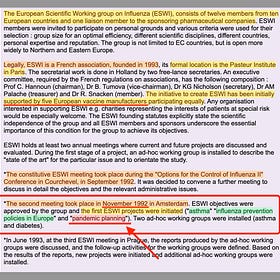Unsurprisingly, evil men didn’t decide to corrupt America - all in one day. Rather, it was a slow, continuous process, culminating with the first revision of a pandemic plan in 1978. So with this in mind, let’s consider the legislative timeline leading up to William Foege signing that document.
Please do note that this is for sakes of tracking down the Pandemic Treaty. Consequently, what matters in this context is the American healthcare system, as the document is that signed by Foege.
-
1944
The Public Service Act comes into law.
This is the first iteration of the Public Health and Safety Act. It relates, primarily, to the legislative basis for providing services in the field of healthcare. It does not contain language relating to coordination of health agencies.
-
1966
Comprehensive Health Planning and Public Health Services Amendments of 1966.
In the 1966 amendment act, conditional grants were made available to Statesestablishing a per-state central agency, responsible for planning of comprehensive health functions. Said grants should additionally supplement money otherwise made available by the state, the agency should function in accordance to standards deemed acceptable to the Surgeon General, annual reports produced and made available to same, and regular reviews were to be carried out - also conditional upon implementation of modifications set by the Surgeon General. And finally - agency councils were to include NGOs representatives.
In a way, it’s a remarkable section - not just because it in effect establishes a hierarchical structure with the Surgeon General sitting at the top, but also because grants made available are conditional upon state funding, ie, a short term financial injection in return for a long-term restructuring of the healthcare system.
The end date of said grants deserve a mention - June 30, 1968.
-
1967
Partnership for Health Amendments of 1967.
Two sections in particular stand out. Section 4 inserts language related to emergencies, and related planning. Emergency planning.
Section 5 further adds language related to clinical laboratories, which now serve as standard components of contemporary pandemic planning.
-
1968
This isn’t about legislative initiatives, but is contextually important.
From above, grants would expire in 1968 (though extended to 1970 through the 1967 act). In contemporary records, 1968 is claimed to have been a ‘minor’ (Hong Kong flu) pandemic, but when you investigate the actual numbers recorded at the time (modification later on allow for abuse), no more than a 22% swing in mortality relative to average is observed. Hardly a pandemic.
And below are the relevant mortality stats, graphed. Sourced via the MMWR archives -
However, annual representation can be misleading, as flu seasons typically run over winter. Consequently, here are those same stats, ‘re-aligned’ from July-July to the extent possible (consequently, fewer years in graph). With an average annual influenza (and pneumonia) mortatily rate around the 25,200 mark, 1968 represent a 23% increase over the norm.
-
1970
A number of interesting developments -
TO THE EDITOR: Health Planning Agencies.
A fairly telling aspect of what took place behind the scenes, is recorded in this letter, and specifically, the following quote -
‘Legislation and other steps are being proposed which appear to move toward changing the area-wide health planning agencies into what Dr. Curran calls "primarily a new political system for decision-making and priority setting in the health field, public or private." Several states, most notably California and New York, have already started down this road through legislation which delegates an official review and comment role to the health planning agency.‘
In short, private interests were already pulling health planning in a direction, undoubtedly more financially interesting from their perspective, but possible also with a long-term goal in mind.
Heart Disease, Cancer, Stroke, and Kidney Disease Amendments of 1970.
Title V propose an environmental study. Sure, you may argue to your hearts content, but the simple fact is that this represents a conflation of health with secondary factors. 1974 saw the release of the Lalonde report, which served as the genesis moment of the Determinants of Health. This could well be considered a stepping stone in that direction.
Family Planning Services and Population Kesearch Act of 1970.
… and we also saw this doozy in 1970 - the introduction of family planning.
-
1974
National Health Planning and Resources Development Act of 1974.
Centrally coordinated health planning. No further comment necessary. I would advice reading the document in full if interested, because there can be no legitimate doubt about intent here.
-
1976
Swine flu episode
A book titled the ‘Swine Flu Affair‘ was released, attempting to legitimise the approach taken in 1976 - but if anything, it’s a testimony to the absolutely ridiculous absurdity of it all. There’s no way this was legitimate. No way. It’s even worse than the appalling 1997 H5N1 fairytale.
See, only an unfortunate individual at Fort Dix died, and he felt rather that remarkably ill he decided to pass on hospitalisation, and go on a hike instead. And no further detail is disclosed about said hike. And furthermore, not a single person outside the Fort tested positive. Not one.
And - naturally - as soon as this ‘pandemic potential’ singular hike-killer struck, the putzer-prize winning New York Times kicked off a fear-mongering campaign, suggesting that this might be ‘the big one’; 1918, part two, so to speak.
The first port of call - naturally - was a cry for surveillance. And during internal debates, they considered vaccinating the entire nation, all because of an illness which might have killed someone going on a hike.
It’s just such incomprehensibly epic fraud that words fail. And the person who reported said to the acting CDC director - William Foege, of all people - was none other than Walter Dowdle, who at the time when the alleged illness broke was elsewhere occupied, …
Rougemont, Switzerland.
Amazingly - at the precise time of outbreak of alleged Swine Flu, a meet in Switzerland (sponsored by Sandoz, now Novartis) took place, discussing what essentially amounts to a pandemic plan. The two main topics on the agenda for the control of said were… surveillance (green), and vaccines (red). In fact, of the 24 sessions, only 3 do not relate to either (blue).
Oh and guess who was present. Yes, Dowdle, who delivered the opening and closing remarks as seen below -
National Consumer Health Information and Health Promotion Act of 1976.
The title is actually the less interesting part (imagine that)! Title II is the meat of the matter, and the title itself is fairly telling - ‘Disease Control’.
In short, a number of of grants are made available for the purpose of immunisation against diseases including tuberculosis, rubella, measles, polio, diphteria, tetanus, pertussis, mumps, and other communicable diseases. Influenza is not present in this list, but with this being the year of Swine Flu allegedly breaking, they are discussing it separately.
What also took place in 1976 was the inclusion of big pharma at the ACIP. This corruption process was continuous, and by 1997, the list of participants look as per below. On this background, it’s appears likely that the ESWI was the solution to them failing to splice pharmaceutical participation into European politics.
-
1978
William Foege's pandemic plan, which I previously covered over here
The US Pandemic Plan, featuring Nancy Cox
In 1993, the Working Group on Influenza Pandemic Pareparedness and Emergency Response - GRIPPE - launched in the US. It was chaired by Nancy Cox, who left in 1996. And hold on to your hats, because the extraordinary coincidences are about to go ballistic.
-
So, to summarise -
1944, The Public Health Service Act comes into law. The primary purpose of which is to serve as a legislative base of proving services.
1966, An amendment is introduced, in short offering grants to states that create a state health agency, responsible for all planning, which report to the Surgeon General of the United States.
1967, Emergency planning, and language specific to the use and improvement of laboratories, is added to the Public Health Service Act.
1970, Family planning is included, and a study on the impact of environment on health is commissioned, thereby opening the door for the inclusion of secondary factors of health.
1974, The first version of a Centralised Health Planning approach is outlined.
1976, Swine Flu breaks while pandemic planning is discussed, and vaccination is introduced in legislative form.
1978, William Foege signs the first pandemic plan.
1992, The European equivalent - the ESWI - is launched at Options for the Control of Influenza II in Courchevel.
-
Look, if you think this timeline is all just a giant coincidence, then I - somewhat facetiously - suggest that perhaps the 1966 inclusion of grants related to mental health services just might have been worthwhile after all.
The ESWI
The ESWI was officially founded in 1993 at the Pasteur Institute in Paris. Prior to formation, the first official meet took place at the ‘Options for the Control of Influenza II' in Courchevel, September, 1992. Kind of telling, really - Courchevel is














